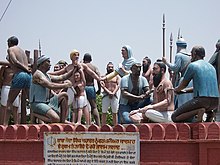ਮਾਰਟਾਇਰ
ਇੱਕ ਮਾਰਟਾਇਰ (ਗ੍ਰੀਕ: μάρτυς, mártys, "ਗਵਾਹ"; ਜੜ μάρτυρ-, mártyr-) ਉਹ ਇਨਸਾਨ ਹੁੰਦਾ ਹੈ ਜੋ ਜੁਲਮ ਸਹਿੰਦਾ ਹੈ ਅਤੇ ਕਿਸੇ ਬਾਹਰੀ ਪਾਰਟੀ ਵੱਲੋਂ ਕੀਤੀ ਗਈ ਮੰਗ ਦੇ ਤੌਰ 'ਤੇ ਕਿਸੇ ਕਾਰਣ ਜਾਂ ਕਿਸੇ ਵਿਸ਼ਵਾਸ ਦੀ ਵਕਾਲਤ ਕਰਨ, ਅਪਣਾਓਣ ਤੋਂ ਇਨਕਾਰ ਕਰਨ, ਸਵੀਕਾਰ ਕਰਨ ਤੋਂ ਮੁੱਕਰਨ, ਜਾੰ ਵਕਾਲਤ ਕਰਨ ਤੋਂ ਇਨਕਾਰ ਕਰਨ ਕਰਕੇ ਮੌਤ ਪ੍ਰਾਪਤ ਕਰਦਾ ਹੈ।

ਅਰਥ
| 1. | A hero | A person of some renown who is devoted to a cause believed to be admirable. |
| 2. | Opposition | People who oppose that cause. |
| 3. | Foreseeable risk | The hero foresees action by opponents to harm him or her, because of his or her commitment to the cause. |
| 4. | Courage and Commitment | The hero continues, despite knowing the risk, out of commitment to the cause. |
| 5. | Death | The opponents kill the hero because of his or her commitment to the cause. |
| 6. | Audience response | The hero's death is commemorated. People may label the hero explicitly as a martyr. Other people may in turn be inspired to pursue the same cause. |
ਹਿੰਦੂਵਾਦ
ਯਹੂਦੀਵਾਦ

ਇਸਾਈਅਤ

ਇਸਲਾਮ

ਸਿੱਖਵਾਦ

ਇਹ ਵੀ ਦੇਖੋ
ਹਵਾਲੇ
ਗ੍ਰੰਥਸੂਚੀ
- "Martyrs", Catholic Encyclopedia
- Foster, Claude R. Jr. (1995). Paul Schneider, the Buchenwald apostle: a Christian martyr in Nazi Germany: A Sourcebook on the German Church Struggle. Westchester, PA: SSI Bookstore, West Chester University. ISBN 978-1-887732-01-7

ਵਿਕੀਕੁਓਟ ਸ਼ਹਾਦਤ ਨਾਲ ਸਬੰਧਤ ਕੁਓਟੇਸ਼ਨਾਂ ਰੱਖਦਾ ਹੈ।

ਵਿਕੀਮੀਡੀਆ ਕਾਮਨਜ਼ ਉੱਤੇ ਸ਼ਹੀਦ ਨਾਲ ਸਬੰਧਤ ਮੀਡੀਆ ਹੈ।
- Fox's Book of Martyrs – 16th century classic book, accounts of martyrdoms
- "Martyrdom from the perspective of sociology" Archived 2015-09-23 at the Wayback Machine.. Encyclopedia of Politics and Religion.
🔥 Top keywords: ਮੁੱਖ ਸਫ਼ਾਰਾਮਨੌਮੀਅਮਰ ਸਿੰਘ ਚਮਕੀਲਾਖ਼ਾਸ:ਖੋਜੋਵਿਸਾਖੀਗੁਰੂ ਨਾਨਕਮਾਰੀ ਐਂਤੂਆਨੈਤਭਾਈ ਵੀਰ ਸਿੰਘਪੰਜਾਬੀ ਭਾਸ਼ਾਭੀਮਰਾਓ ਅੰਬੇਡਕਰਗੁਰੂ ਗੋਬਿੰਦ ਸਿੰਘਅੰਮ੍ਰਿਤਾ ਪ੍ਰੀਤਮਗੁਰੂ ਗ੍ਰੰਥ ਸਾਹਿਬਗੁਰੂ ਅਰਜਨਪੰਜਾਬੀ ਸੱਭਿਆਚਾਰਪੰਜਾਬ, ਭਾਰਤਗੁਰੂ ਅੰਗਦਦੂਜੀ ਸੰਸਾਰ ਜੰਗਭਗਤ ਸਿੰਘਗੁਰੂ ਤੇਗ ਬਹਾਦਰੴਪੰਜਾਬੀ ਲੋਕ ਬੋਲੀਆਂਪੰਜਾਬੀ ਲੋਕ ਖੇਡਾਂਵਿਕੀਪੀਡੀਆ:ਬਾਰੇਗੁਰੂ ਅਮਰਦਾਸਹਾੜੀ ਦੀ ਫ਼ਸਲਗੁਰੂ ਹਰਿਗੋਬਿੰਦਬਾਬਾ ਬੁੱਢਾ ਜੀਪੰਜਾਬ ਦੇ ਮੇਲੇ ਅਤੇ ਤਿਓੁਹਾਰਪੰਜਾਬ ਦਾ ਇਤਿਹਾਸਸਿੱਧੂ ਮੂਸੇ ਵਾਲਾਸ਼ਿਵ ਕੁਮਾਰ ਬਟਾਲਵੀਪੰਜ ਪਿਆਰੇਹਰਿਮੰਦਰ ਸਾਹਿਬਪੰਜਾਬੀ ਮੁਹਾਵਰੇ ਅਤੇ ਅਖਾਣਭਾਰਤਅਨੁਵਾਦਸਤਿ ਸ੍ਰੀ ਅਕਾਲਵਿਕੀਪੀਡੀਆ
